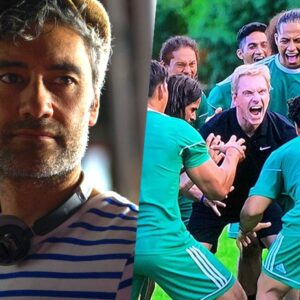
This week sees the highly-anticipated release of nêhiyawak’s stunning debut album, nipiy, marked with today’s arrival of the music video for “tommaso” by Maskwacis, Alberta-based filmmaker Maria Buffalo.
The song – which combines Marek Tyler’s momentous krautrock rhythm and the terrestrial beat of Indigenous percussion, Matthew Cardinal’s swirling electric melodies, and Kris Harper’s resounding vocals – is enhanced by Buffalo’s remarkably personal dedication to community. nipiy is out today on Arts & Crafts.
nêhiyawak ᓀᐦᐃᔭᐊᐧᐠ, NEH-hee-oh-wuk, meaning the Cree People, People of the Plains, Plains People, Exact People, Free People. As the Cree language does not capitals, nêhiyawak hails from amiskwaciy (Edmonton) on Treaty 6 territory. On the band’s debut album, nipiy, the trio of Indigenous artists – Kris Harper (vocals, guitars), Marek Tyler (drums), and Matthew Cardinal (synths, bass) – transcends a new intersection of traditional storytelling and modern sound.
nêhiyawak – whose name refers directly to their nêhiyaw ancestry – is a spirited expression of Indigeneity.
nipiy, which translates to water, is the title of nêhiyawak’s first full length album. The flow and pace of the album, symbolic of the flow and pace of water, begins and ends with pieces dedicated to kisiskâciwanisîpiy (North Saskatchewan River), a river that flows through the center of amiskwaciy. In the band’s words, “There are many important ideas and teachings that we were raised with in our lives, but few more important than water. It’s a modern conversation with complex meanings and understandings.”
“It is a testament to the properties of the element it strives to represent, and a beacon of hope for communities to learn from and grow with each other. Astounding and worth every minute of its running time,” wrote Exclaim!
“the sound of prairies sighing, of mountains uprising, of rivers racing and skies splitting open, all devoted to investigating their land, history, and heritage,” wrote Beatroute
Buffalo offers this insight on nêhiyawak’s song and her directorial debut: “My vision for ‘tommaso’ has been in the making for years. ‘tommaso’ was the first track I listened to from nêhiyawak and I instantly fell in love and I felt at home. When I was approached to do this I was over the moon. During the early stages I was in an indigenous literature class and we were studying indigenous erotica. Its main praxis – and what I wanted my art specifically to explore – is how indigenous bodies are an extension of the land. Growing up on the reservation, that was something I understood from a young age. I grew up on the land. It created me. The track of tommaso was very much about love and devotion. So it made sense to take this chance to create this love letter to my home and my community, and to the band. It was vital for me to make sure this was actually shot on my reservation and to include talent from my community as well (with Hunter from Sucker Creek as the exception). We then decided on a location and suddenly it became something so much more personal to me. My Kokum Sadie generously allowed us to film in her home and she agreed to star in it as well. So it suddenly became a family affair. Which was wickedly sacred and beautiful. For my entire family and community to come together to bring to life this story. To structure the video a bit more while doing shortlists and soft blocking I decided to focus on four main people in the four main stages of life. Showing all these beautiful brown bodies and what they contain. This was the story of our land. This was a love story. With indigenous bodies and the land. And with each other.”
Songwriter Kris Harper says he wrote “tommaso” with the history of the European Renaissance in mind.
“I felt like there is an incredible love story to be examined between Michaelangelo and Tommaso,” says Harper. “As well to point out to some of the realities of having the master’s work commissioned required the spoils of colonial exploits. For me the idea of having another indigenous artist (Maria Buffalo) visualize concepts knowing some of the back story of the lyrics in the music, but relating that to images of Maskwacis First Nation, the body, hands, and indigenous people; I could imagine an incredible juxtaposition. The story of the song deepens with additional perspectives working their own ideas into this piece.”
Produced by Colin Stewart (The New Pornographers, Black Mountain, Destroyer), nêhiyawak’s sound combines terse post-rock soundscapes with surreal pop and sheer ambient aspects. Anchored by the hollowed pounding of Tyler’s traditional carved cedar log drums and Cardinal’s electronic inflections, nipiy combines the teachings of nêhiyawak’s Elders with the band’s own interests in music, instrumentation and lyrics. nipiy tells their story of collective experience – a band empowered by history and progress, compelled to add to the great body of work.











